What’s in a roof? Well apparently a whole lot. There’s a fast growing movement around the world to paint roofs white or at least a very light shade of grey for it’s light reflecting qualities. Sited by the British ‘Institute of Mechanical Engineers’ in 2009 as one of the top three measures we can take to mitigate global warming effects, and it has gained attention from some of the world’s most influential organisations and leaders including President Obama. The European Union funds Cool Roofs Europe, and the Green Building Council’s Leadership in Energy and Environmental Design (LEED) rating system requires buildings roofs to comprise of at least 75% reflective materials.
According to whiteroofs.org.nz, there is a fascinating ‘real life’ example in the provence of Almeria, Spain, where large scale greenhouse agriculture is the predominant industry. There the farmers paint their greenhouse roofs white in summer to stop the plants from becoming too hot. The effect is that each decade the area’s temperature has been dropping by 0.8 degrees. It is now on average 1.5 degrees cooler than the surrounding regions.
I had a look for myself on google maps and the view is indeed quite amazing! Here are a few screenshots I took.
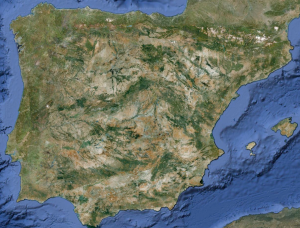
If you look carefully at this satellite image of spain you can see Almeria's greenhouse agricultural area on one of the South-Eastern most points. It appears a much lighter colour than the surrounding area.
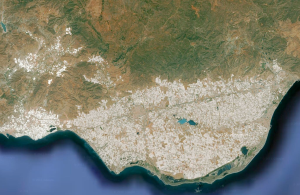
This 'white roofs' geographical feature is manmade and can be considered a form of Geo-Engineering, something which we will hear more and more about in the coming years.
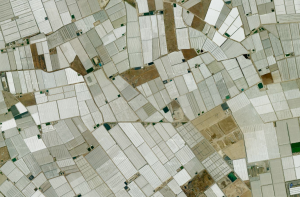
In Almeria farmers paint their greenhouse roofs white in summer to stop them from overheating, and the cumulative effect is awesome. Almerians have achieved the reverse of what happens in cities around the globe - namely the 'heat island effect' where urban temperatures are far higher than in surrounding areas.
Here’s an excerpt from The White Roofs Project NZ to explain why this is such an important idea:
‘The White Roofs Project NZ is promoting white and off-white roofs as simply one of the fastest and lowest cost ways of helping reduce global warming, by mimicking the way the polar icecaps reflect sunlight back into space and help cool our planet. If your building has air conditioning a white roof may result in lower electricity use and reduced carbon emissions, and if your building does not have air conditioning you may benefit from a cooler building. In many cases it does not involve additional costs when a roof needs maintenance anyway.
When sunlight falls on a white roof, about 55% is reflected and much of this goes back into space, whereas a dark roof absorbs most of the sunlight and re-radiates it as heat, which gets absorbed by greenhouse gases in the atmosphere and does not make it back into space. And that is why a white roof helps cool the planet and a dark roof warms the planet.’
In our sharing, caring community of Kakariki Street + neighbours, friends and relatives, the idea of painting our roofs white or light colours was floated via a generously broadcast email. It was timely for some, while others just missed out having already bought the paint with which to re-colour their roof. However three of us are able to act on this advice and will do so in the next few months. Two of us are Kakariki Street-ers – the other house owner is a neighbor in our communication loop. When I look around our neighbourhood I see a total of 4 light/white roofs from my garden.
The website also says that: ‘When new roofs are chosen or when roofs come up for regular maintenance, the choice to go white or off-white comes at no extra cost in many cases, and gives the opportunity to do good without it hurting your pocket.’
I have seen some comments that say the benefits of this approach are cancelled out or even negative in colder climates where a building’s energy usage is higher in winter for heating than it is in summer for cooling. Upon further analysis this would appear to not be entirely true as the winter sun is low in the sky, so a roofs thermal gain in winter is far less than in summer. The need for heating our houses also occurs predominantly outside of the main sunlight hours in the late afternoon and evening. A well insulated wooden house (average houses in New Zealand are wooden, though not always insulated), receives most of it’s thermal gain from sunlight entering through its windows.
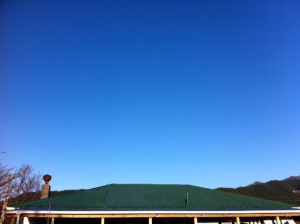
Our roof is dark green and in that respect a pretty unhelpful kind of roof, not the sort you want if you're a greenie!
Our house, like the majority of New Zealand houses, has a corrugated iron roof. Unlike some houses, it also has a thick layer of insulation in the ceiling cavity. The roof, having virtually no thermal mass, is not designed to store heat and slowly release it during the night to keep us all warm. The insulation offers a further barrier to the heat entering our house from above -which becomes quite apparent on a hot day when the inside temperature is lovely and cool. Our house does however have a dark green roof that converts light into radiant heat -exactly the sort that gets trapped in the earth’s atmosphere by greenhouse gasses, so I think we’d be well advised to go for a lighter roof colour.
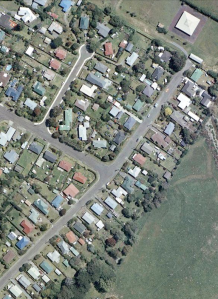
Imagine how different this picture could look if all the houses had white, or very light coloured roofs. Spot the difference next time Google updates their pictures, because we hope that there'll be at least three new ones!
Wouldn’t it be cool if in a few years time Paekakariki -or even Kapiti,
could be spotted on Google Earth from a great height like Almeria in Spain, because it was covered in white roofs!

Hi F.
It’s great to see what you Kakariki people are up to and nice to link up with others working for a positive change. I see you’ve been doing your homework on white roofs. I didn’t know about the British Institution of Engineers’ position on white roofs until I saw it on your website and this is timely because next month I’m giving a talk at the Engineers for Social Responsibility monthly meeting in Auckland.
A number of people have asked me about the issue that if you live in a cooler climate should you use a white roof? Or to put it another way, if a white roof cools your building in summer will it also cool it in winter, and if you live in a cool climate will this mean that the summer cooling savings from reduced air conditioning use are outweighed by needing to use your heating more in winter, and would a dark roof be better if you want to reduce costs and emissions? Some blogs and articles I have read are of the opinion that if the number of cooling days is less than the number of heating days, that you are better off with a dark roof, but these opinions are not backed by science. As I shall discuss, the number of cooling days versus heating days (or even the cooling degree days versus heating degre days) is not a measure of annual energy and emissions savings between a white roof and a dark roof.
A white roof cools the planet in two ways: (1) by reflecting sunlight back into space, and (2) by cooling the roof so that less heat comes into the building, so for buildings with air conditioning it reduces energy use and emissions, and for buildings without air conditioning it gives a cooler house that is more pleasant to inhabit in summer.
For buildings with air conditioning, studies have shown that if you have demand for cooling in summer and heating in winter, a white roof pays off in energy cost savings and in emission savings. A recent study, probably the most rigorous ever undertaken on this issue, considered commercial buildings across the USA and found that savings are greatest in the hotter parts of the country (such as near the Mexico border) and less in cooler parts (such as near the Canadian border) but still savings. Does this interest you? Then read on! I’ll talk more about this below.
But first I’ll talk about the pros and cons of white roofs on houses that do not have air conditioning. If a house is comfortable in summer and does not need cooling but does need heating in winter, and if say global warming is not an issue for the occupiers, and helping to cool the planet by reflecting sunlight back into space is not an issue for them either, then they can use a darker roof but it seems it’s not going to help them much with their winter heating bill for the following reasons.
– In winter the sun is much less intense than summer, and the difference in temperature between a white roof and a dark roof (which can peak at more than 35ºC in summer) is much smaller in winter. In many locations where the winter sunlight is typically only one third that in summer and it could be said that each summer cooling day is worth about three winter heating days, so simply comparing the number of cooling days to the number of heating days is misleading.
– In winter there are far more cloudy days than in summer, and at those times the difference in temperature between a white and a dark roof may be small or negligible, and in winter the days are shorter and there are significantly fewer sunshine hours than summer. If there is no sunshine on the house then it does not matter what colour your roof is. Again, simply comparing the number of cooling days to the number of heating days is misleading.
– In winter the sun is at a lower angle in the sky and so roofs are often in shade a lot more, and houses typically have a greater proportion of sunlight on walls and windows and a lesser proportion on the roof than in summer. This further lowers the difference in temperature between a white and a dark roof. Many houses have eaves designed to shade the windows in summer when the sun is more overhead, and designed to let the sun through the windows in winter when it is at a lower angle. It seems that in winter, the amount of solar heating coming directly through windows may be significantly more than solar heating via the roof, (but we have not found any studies to quantify this). Again, simply comparing the number of cooling days to the number of heating days is misleading.
– In winter, most of the heating is in early morning and early evening, and at these times the sun is not shining on the roof (usually because it is dark or the sun not high enough in the sky), so at the time you might need the solar heating the most it is not there and it makes no difference what colour the roof is.
– For houses in very cold climates where there is rooftop snow in winter, the roof cannot ‘see’ the sun and it does not matter what colour your roof is.
So simply comparing the number of cooling days to the number of heating days does not indicate the effects of installing a white roof. On balance it seems that a white roof might have only minimal effect on heating cost and emissions in winter and that this is far outweighed by the contribution to cooling the planet by reflecting sunlight back into space. Research has shown that 100 square metre of flat white roof (a modest sized house without a garage) reflects enough sunlight back into space to give a cooling effect that cancels the global warming of roughly 10 tonne of CO2 emissions (the amount emitted by 2.5 average cars for one year).
If a house has a dark roof then it’s going to be hotter in the summer sun and the house hotter to live in. So a white roof gives you some free cooling in summer, which is why it has been used for thousands of years in places like the Mediterranean and Middle East countries.
Probably the most rigorous study on the energy efficiency of using white roofs compared to dark roofs was by the engineers at the Heat Island Group, Lawrence Berkeley National Lab, California, published in the Journal of Energy Efficiency, 2010 (see the Science page on the White Roofs website for a link to it). The study models four types of commercial construction (new/old retail and office), as well as local energy prices and local electricity emission factors. It gives results across the US for average values of cooling energy savings, heating energy penalties, and overall energy cost savings per square metre of conditioned roof area, as well as emissions reductions. The simulation was for buildings with electric cooling and natural gas heating. The study finds that the savings are greatest in the hotter parts of the country and less in the cooler parts but that even in these cooler parts there are still savings. The study estimates that immediately retrofitting 80% of 2.58 billion m2 of commercial building in the USA would yield an annual cooling energy saving of 10.4 TWh, an annual heating energy penalty of 133 million therms, and an annual energy-cost saving of $735 million. It would also offer an annual CO2 reduction of 6.23 Mega tonne, offsetting the annual emission of 1.2 million cars or 25.4 peak power plants.
Go Kakarikians!
Ian
Hi F
I mentioned in the white roofs newsletter last week that a couple of community groups had decided to incorporate the white roofs idea in their local eco activities. This might seems like a silly question, but I had an enquiry from someone who read that saying that she would love to know more about this so she could include a snippet in her newsletter for the Awakening the Dreamer symposium here in Auckland (awakeningthedreamer.org is about global warming reduction). I’m not sure whether you want to go public on that yet, so I thought I’d better ask before directing her to your website.
Ian
Hi Ian
Yes you can direct her to our website that’s welcome, but I’m not sure if any of us have plans to paint or re-roof in the middle of winter’s storms and gales! I’m guessing our street will start changing colour over summer.
Cheers
Flo
Hi Flo.
I’ll pass this page address on to Alyssia.
Thanks
Ian
Oh Ian!
I take that back about nothing happening until summer… Perhaps because of the winter storms and gales, two households got new white roofs this week! Photos will follow.
Cheers
Flo